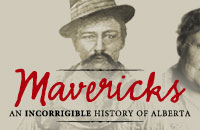 |

[ Project Plans | Essential
Questions | Knowledge Hunt | Glossary | Links ]
Becoming a Western Legend
Using Role Play to Understand the Maverick's Character and
Perspective in Alberta History
Introduction
Students need to understand how the stories of the early mounted
police have contributed to the development and culture of Alberta.
What was day-to-day life like for the early Mounties? How did they
meet their basic needs? How did these Mavericks change the way people
lived in Alberta? Why are they considered legendary? What do their
stories tell us about Alberta and its development?
Project Explanation
In this project, students will develop an appreciation of the life
and history of an Alberta Maverick by taking on their character
and personality. Using one or more styles of presentation as individuals
or in groups, they will thoroughly "tell" the story
of a Maverick in a "First Person" format by acting as
the Maverick themselves. They will research any information that
they deem significant for others to feel that they truly "know"
that character. The students will then assemble it into a finished
presentation by gathering props, finding costumes, using accents
and speech mannerisms, and deciding upon the background setting.
The presentations can then be shared with the entire class.
Alberta Social Studies Curriculum Unit Connections
Grade Four - Alberta: The Land, Histories and Stories
4.2 The Stories, Histories and People of Alberta
Grade Five - Canada: The Land, Histories and Stories
5.2 Histories and Stories of Ways of Life in Canada
Grade Seven - Canada: Origins, Histories and Movement of People
7.2 Following Confederation: Canadian Expansions
Materials and Resources Needed
Procedures
Students will create a "First-Person" role-playing
presentation about a historical Maverick. Telling the story as that
character (First-Person Narrative) may be introduced using picture
books such as:
- Encounter by Jane Yolen (excellent historical First-Person
story)
- Rosie and Michael by Judith Viorst
- Alexander and the Terrible, Horrible, No-Good, Very Bad Day
by Judith Viorst
- The Polar Express by Chris Van Allsburg
- The True Story of the Three Little Pigs by John Scieszka
- Grandfather's Christmas Tree by Keith Strand
Students may tell the story as the Maverick themselves, or they
could tell it from the perspective of their wife, husband, child,
friend, enemy, competitor or ancestor. Possible presentation formats
could include:
- a live presentation
- a digital video production
- a PowerPoint presentation
- a puppet show
- a play
- poetry
- an old Mountie song
Students then brainstorm the questions they would need to find
out about their Maverick. They might include:
- What was their day-to-day life like?
- What were their contributions to their field or to the province
of Alberta?
- What were the challenges/hazards/obstacles they faced?
- Were they successful?
- Why were they successful? Why? (Was it their traits, skills,
attitudes, special knowledge, specific event from their past,
luck?)
- What do you think helped to drive them?
- What held them back?
- What did others think of them?
- Did everyone like/dislike them? Why did certain people like/dislike
them?
- What was Alberta like in their time? What was their historical
context?
- What was the one most important event in their life? What day
will they never forget?
Research and information may be found using the Mavericks: An
Incorrigible History of Alberta site, other web resources, the
Glenbow museum, primary artifacts, historical documents and photographs,
and local history books.
They would then take the information they have researched and synthesize
it into a presentable story with a clear beginning, middle, and
end, making sure it will be interesting for their audience. Students
will gather or create props, artifacts, or clothing articles that
may use to add to their presentation for their classmates.
Assessment and Evaluation
- Students and their teacher should develop their own rubric by
identifying evaluation criteria for the project that will match
their own learner outcomes. This allows students to understand
the expectations for their work and to have input into the ongoing
evaluation process.
- In groups or as a class, students may conference and debrief
each other after they have presented their projects. Students
should be encouraged to share their personal reflections about
how it felt to speak in front of their audience.
- Students may evaluate themselves and their peers using their
project rubric, examining each other's project for historical
accuracy, detail, and creativity.
- Students should use their journal to reflect upon their group
dynamics, how the problem solving process worked, their solutions
to the problem, what could have been done differently or better,
and any successes or frustrations they felt when working with
their group.
- The final student presentations may be videotaped in order to
be shared, re-examined, and evaluated. These may also be shared
or evaluated along with their parents or be presented at student-led
conferences.
Ideas for Enriching this Project
- Two (or more) students could work together to tell the main
character's story from the perspective of the whole family.
- Students could take on the roles of opposing groups and compare
the different perspectives of historical characters and attempt
to persuade their peers that their viewpoint was correct.
 |



![]()
